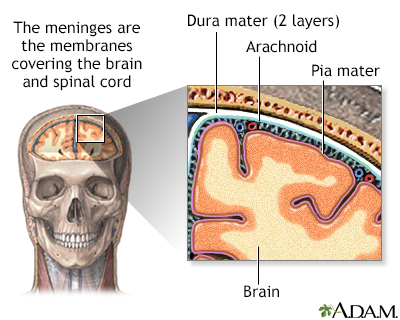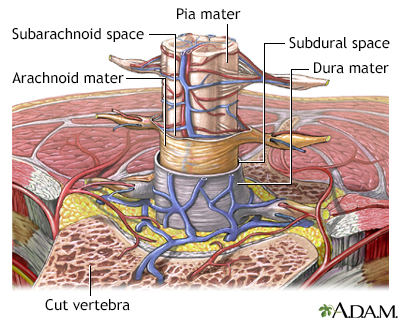Epidural abscess
An epidural abscess is a collection of pus (infected material) and germs between the outer covering of the brain and spinal cord and the bones of the skull or spine. The abscess causes swelling in the area.
Abscess
An abscess is a collection of pus in any part of the body. In most cases, the area around an abscess is swollen and inflamed.

Causes
Epidural abscess is a rare disorder caused by an infection in the area between the bones of the skull, or spine, and the membranes covering the brain and spinal cord (meninges). This infection is called an intracranial epidural abscess if it is inside the skull area. It is called a spinal epidural abscess if it is found in the spine area. Most are located in the spine.
The spinal infection is usually caused by bacteria but may be caused by a fungus. It can be due to other infections in the body (especially a urinary tract infection), or germs that spread through the blood. In some people, though, no other source of infection is found.
An abscess inside the skull is called an intracranial epidural abscess. The cause may be any of the following:
- Chronic ear infections
Chronic ear infections
Chronic ear infection is fluid, swelling, or an infection behind the eardrum that does not go away or keeps coming back. It may cause long-term or p...
 ImageRead Article Now Book Mark Article
ImageRead Article Now Book Mark Article - Chronic sinusitis
Sinusitis
Sinusitis is present when the tissue lining the sinuses become swollen or inflamed. It occurs as the result of an inflammatory reaction or an infect...
 ImageRead Article Now Book Mark Article
ImageRead Article Now Book Mark Article - Head injury
- Mastoiditis
Mastoiditis
Mastoiditis is an infection of the mastoid bone of the skull. The mastoid bone is located just behind the ear.
 ImageRead Article Now Book Mark Article
ImageRead Article Now Book Mark Article - Recent neurosurgery
An abscess in the spine is called a spinal epidural abscess. It may be seen in people with any of the following:
- Prior back surgery or another invasive procedure involving the spine
- Bloodstream infections
- Boils, especially on the back or scalp
Boils
A boil is an infection that affects groups of hair follicles and nearby skin tissue. Related conditions include folliculitis, an inflammation of one ...
 ImageRead Article Now Book Mark Article
ImageRead Article Now Book Mark Article - Bone infections of the spine (vertebral osteomyelitis)
Osteomyelitis
Osteomyelitis is a bone infection. It is caused by bacteria or other germs.
 ImageRead Article Now Book Mark Article
ImageRead Article Now Book Mark Article
People who inject illicit drugs are also at increased risk.
Symptoms
Spinal epidural abscess may cause these symptoms:
- Bowel or bladder incontinence
Bowel
Bowel incontinence is the loss of bowel control, causing you to unexpectedly pass stool. This can range from sometimes leaking a small amount of sto...
 ImageRead Article Now Book Mark Article
ImageRead Article Now Book Mark ArticleBladder incontinence
Urinary (or bladder) incontinence occurs when you are not able to keep urine from leaking out of your urethra. The urethra is the tube that carries ...
 ImageRead Article Now Book Mark Article
ImageRead Article Now Book Mark Article - Difficulty urinating (urinary retention)
- Fever and back pain
Intracranial epidural abscess may cause these symptoms:
- Fever
- Headache
- Lethargy
- Nausea and vomiting
- Pain at the site of recent surgery that gets worse (especially if fever is present)
Nervous system symptoms depend on the location of the abscess and may include:
- Decreased ability to move any part of the body
- Loss of sensation in any area of the body, or abnormal changes in sensation
Loss of sensation
Numbness and tingling are abnormal sensations that can occur anywhere in your body, but they are often felt in your fingers, hands, feet, arms, or le...
 ImageRead Article Now Book Mark Article
ImageRead Article Now Book Mark Article - Weakness
Exams and Tests
Your health care provider will perform a physical exam to look for a loss of functions, such as movement or sensation.
Tests that may be done include:
- Blood culture to check for bacteria in the blood
Blood culture
A blood culture is a laboratory test to check for bacteria or other germs in a blood sample.
 ImageRead Article Now Book Mark Article
ImageRead Article Now Book Mark Article - Complete blood count (CBC)
Complete blood count
A complete blood count (CBC) test measures the following:The number of white blood cells (WBC count)The number of red blood cells (RBC count)The numb...
 ImageRead Article Now Book Mark Article
ImageRead Article Now Book Mark Article - CT scan of the head or spine
CT scan
A computed tomography (CT) scan is an imaging method that uses x-rays to create pictures of cross-sections of the body. Related tests include:Abdomin...
 ImageRead Article Now Book Mark Article
ImageRead Article Now Book Mark Article - Draining of abscess and examination of the material
- MRI of the head or spine
MRI
A magnetic resonance imaging (MRI) scan is an imaging test that uses powerful magnets and radio waves to create pictures of the body. It does not us...
 ImageRead Article Now Book Mark Article
ImageRead Article Now Book Mark Article - Urine analysis and culture
Culture
A urine culture is a lab test to check for bacteria or other germs in a urine sample. It can be used to check for a urinary tract infection in adults...
 ImageRead Article Now Book Mark Article
ImageRead Article Now Book Mark Article
Treatment
The goal of treatment is to cure the infection and reduce the risk for permanent damage. Treatment usually includes antibiotics and surgery. In some cases, antibiotics alone are used.
Antibiotics are usually given through a vein (IV) for at least 4 to 6 weeks. Some people need to take them for a longer time, depending on the type of bacteria and how severe the disease is.
IV
Intravenous means "within a vein. " Most often it refers to giving medicines or fluids through a needle or tube inserted into a vein. This allows th...
Read Article Now Book Mark ArticleSurgery may be needed to drain or remove the abscess. Surgery is also often needed to reduce pressure on the spinal cord or brain, if there is weakness or damage to the nerves.
Outlook (Prognosis)
Early diagnosis and treatment greatly improve the chance of a good outcome. Once weakness, paralysis, or sensation changes occur, the chance of recovering lost function is greatly reduced. Permanent nervous system damage or death may occur.
Paralysis
Muscle function loss is when a muscle does not work or move normally. The medical term for complete loss of muscle function is paralysis.

Possible Complications
Complications may include:
- Brain abscess
Brain abscess
A brain abscess is a collection of pus, immune cells, and other material in the brain, caused by a bacterial or fungal infection.
 ImageRead Article Now Book Mark Article
ImageRead Article Now Book Mark Article - Brain damage
- Bone infection (osteomyelitis)
- Chronic back pain
- Meningitis (infection of the membranes covering the brain and spinal cord)
Meningitis
Meningitis is an infection of the membranes covering the brain and spinal cord. This covering is called the meninges.
 ImageRead Article Now Book Mark Article
ImageRead Article Now Book Mark Article - Nerve damage
- Return of infection
- Spinal cord abscess
Spinal cord abscess
Spinal cord abscess is the swelling and irritation (inflammation) and the collection of infected material (pus) and germs in or around the spinal cor...
 ImageRead Article Now Book Mark Article
ImageRead Article Now Book Mark Article
When to Contact a Medical Professional
An epidural abscess is a medical emergency. Go to the emergency room or call 911 or the local emergency number if you have symptoms of a spinal cord abscess.
Prevention
Treatment of certain infections, such as ear infections, sinusitis, and bloodstream infections, may decrease the risk for an epidural abscess. Early diagnosis and treatment are important to prevent complications.
Ear infections
Suspected ear infections are one of the most common reasons parents take their children to their health care provider. The most common type of ear i...

Sinusitis
Sinusitis is present when the tissue lining the sinuses become swollen or inflamed. It occurs as the result of an inflammatory reaction or an infect...

Reviewed By
Jatin M. Vyas, MD, PhD, Professor in Medicine, Harvard Medical School; Associate in Medicine, Division of Infectious Disease, Department of Medicine, Massachusetts General Hospital, Boston, MA. Also reviewed by David C. Dugdale, MD, Medical Director, Brenda Conaway, Editorial Director, and the A.D.A.M. Editorial team.
Rajasekaran S, Viswanathan VK, Shetty AP. Primary infections of the spine. In: Steinmetz MP, Berven SH, Benzel EC, eds. Benzel's Spine Surgery. 5th ed. Philadelphia, PA: Elsevier; 2022:chap 44.
Tunkel AR. Subdural empyema, epidural abscess, and suppurative intracranial thrombophlebitis. In: Bennett JE, Dolin R, Blaser MJ, eds. Mandell, Douglas, and Bennett's Principles and Practice of Infectious Diseases. 9th ed. Philadelphia, PA: Elsevier; 2020:chap 91.


 All rights reserved.
All rights reserved.